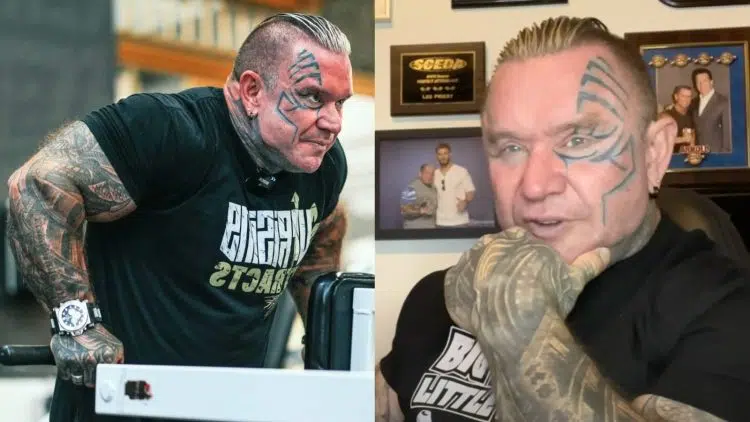Known for his freaky arms and dry conditioning, Lee Priest was ahead of his time competing in the IFBB Pro League. In a recent IFBB AMA YouTube video, Lee Priest opened up on workout frequency, bulking, and his best training splits.
From contest prep diets to optimal protein intake, Lee Priest continues to serve the bodybuilding community in retirement. During his illustrious career, Priest built a sterling reputation defeating mainstays of the Men’s Open, from the great Ronnie Coleman to Chris Cormier and Milos Sarcev.
Having led a one-of-a-kind tenure in the sport, Lee Priest capitalized on intense training. He regularly pushed himself to perform three hours of cardio while in contest preps. With questions about what training systems worked best for him, Priest revealed the pros and cons of a few of his favorite workout splits.
Lee Priest Examines Best Training Splits He Used During Bodybuilding Career, Opens Up on Workout Frequency
According to Priest, when he first started in the sport, he utilized a full body workout split on Mondays, Wednesdays, and Fridays.
Level Up Your Fitness: Join our 💪 strong community in Fitness Volt Newsletter. Get daily inspiration, expert-backed workouts, nutrition tips, the latest in strength sports, and the support you need to reach your goals. Subscribe for free!
“When I was young first starting out, I used to do the full body. Monday, Wednesday, Friday. Now, I think to myself, shit, imagine doing the full body now. That might peak, by the time you do one body part say legs, you’d be like, imagine when I was younger I use to do legs, then back, then chest, then shoulders, then arms, all into one workout.”
After experimenting with a full body split, Priest tried training one body part a day for five days straight before taking rest.
“I guess it could be done, like I said, as long as you’re focused and you got your mind in the muscle and eating well. But then, there was times I’d do one body part a day. I started with legs Monday, back, chest, shoulders, arms, so that’d be five days on, one day off.”
Listening to the body was important for Priest which helped him adopt an instinctive approach to training.
“Then, like I said, the day I’d go to take off, I might be like, you know what? I feel like I want to train. This is where you have to be really instinctive, if you feel like you want to train, go train because you’re going to have those days where if you’re training five days, maybe that fourth day, you’re like oh god.
I just can’t. Whether you didn’t eat enough, didn’t get enough sleep, if you’re working a normal job, family commitments. Sometimes, you’re just like ew, I just don’t want to do it. If I go to the gym it would be like I’m going through the movements.”
If he lacked the desire to train, Priest would start by going to the gym for cardio and calf work. He recommends saving leg training for the weekend so it’s not rushed before or after work throughout the week.
“So, what I used to do was maybe, I’d pick another body part or just go there and I’d start off maybe doing cardio and calves. Sometimes, because legs are such a big body part, if you don’t work weekends and you can train on the weekend or sometimes you’re spending family time, save the big body part for the weekend that way you’re not rushing before work to do them or after work.”
While bulking up, Priest mentioned that a one-on-one-off split worked best for him.
“In the off-season, you know, if you trained three or four days or five, the first day oh yeah, second day yeah, third day yeah, but then the fourth day, you could just be a little bit tired and the fifth day a little bit tired. One of my best things was when I was bulking up, was one-on one-off one-on one-off, I might go twice a day.”
He also tinkered with two-a-days, preferring to train legs in the morning and shoulders at night or chest first, and arms at night.
“I might do like legs in the morning and then shoulders at night. Then, have a day off and then the next day do chest in the morning, arms at night. The thing is like I said, when you’re training one day, next day, next day, you’re thinking I’m a bit tired and you got to get the food in,” shares Lee Priest.
One benefit to the one-on-one-off training split is that you can push harder in workouts knowing you’ll have the following day to recover.
“You’re so excited, this way it’s like you go fucking balls to the wall, fuck yeah, I got tomorrow off. That’s why you do the one-on-one-off in the off-season because when I say a day off, you can still do a bit of cardio and calves but blasting the body, pick two body parts, that’s like because you know tomorrow is your day off so you might train an hour or two. And I mean fucking annihilate it because in your mind you’re thinking tomorrow I don’t have to train.”
Aside from his training practices, Lee Priest has been open about his struggles outside of bodybuilding. At one point, he was forced to detox from prescription painkillers after a neck surgery. To come off the medicine safely, Priest was overseen at a local hospital.
Having implemented just about every training split available to him, Lee Priest managed to find the most success in a bulking context with a one-on-one-off program. Given his achievements, longevity, and health, it’s safe to say his training efforts paid off in the end.
RELATED: Lee Priest Discusses His 1,017-Rep Leg Press Set in Prime of His Career for $200 Bet









